Shooting for the Moon
Fifty years ago this May, John F. Kennedy molded Cold War fears into a collective resolve to achieve the almost unthinkable: land American astronauts on the moon. In a new book, Professor Emeritus John Logsdon mines the details behind the president's epochal decision.
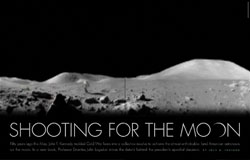
![]()
During the last manned mission to the moon, in 1972, Apollo 17 astronaut Harrison Schmitt bounds back to the lunar rover.
NASA/courtesy of nasaimages.org
In the middle of a July night in 1969, standing outside a faceless building along Florida's eastern coast, three men in bright white spacesuits strolled by, a few feet from me—on their way to the moon.
They climbed into their spacecraft, atop a massive Saturn V rocket, and, a few hours later, with a powerful blast, went roaring into space, the weight on their shoulders far more than could be measured in g-forces.
Their mission was to be the culmination of the government's largest-ever peacetime program, a triumph of American ingenuity and gumption, and the fulfillment of a challenge left behind by a slain leader.
In May 1961—50 years ago—President John F. Kennedy had called for a national effort to take up "a great new American enterprise" in a speech before a joint session of Congress.
"I believe," he said, "that this nation should commit itself to achieving the goal, before this decade is out, of landing a man on the moon and returning him safely to the Earth."
The rest, of course, is history: The Eagle landed. Before a TV audience of half a billion people, Neil Armstrong took "one giant leap for mankind," and Buzz Aldrin emerged soon after, describing the moonscape before him as "magnificent desolation."
But the landing at Tranquility Base was not the whole story of Project Apollo.
It was the story behind the story that had placed me at Kennedy Space Center that July day. I had recently finished an effort to detail the events that led to President Kennedy's cosmic call to action and had the good fortune to be there for its stunning conclusion.
That effort was the first draft of my 1970 book, The Decision to Go to the Moon: Project Apollo and the National Interest, a study that became the standard account of how the president made his choice. The same year, I joined the faculty at GW, where in 1987 I founded the Space Policy Institute at the Elliott School of International Affairs and where I taught for 38 years before leaving the active faculty in 2008.
Complete as the book was for 1970, it became apparent to me over the years that there were gaps in my account.
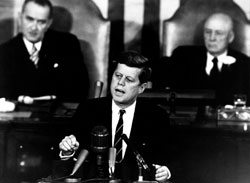
President John F. Kennedy, addressing a joint session of Congress on May 25, 1961, calls for "a great new American enterprise."
NASA/courtesy of nasaimages.org
The book drew heavily on a wealth of original interviews comprising nearly everyone involved in the decision to go to the moon—with the exception of President Kennedy and his brother, Robert, both lost to assassins, and then-President Lyndon Johnson and Defense Secretary Robert McNamara, who both declined to be interviewed. With the passage of time, a trail of primary documents that would provide many new insights had become available.
Four decades later, I returned to the topic to fill in those gaps.
My just-published study, John F. Kennedy and the Race to the Moon, offers a more complete and nuanced look at President Kennedy's crucial role in sending Americans to the moon.
The story of John F. Kennedy's involvement with the American space program did not get off to a promising start.
Mr. Kennedy came into the White House in January 1961 knowing or caring little about the U.S. space effort; however, within three months he became convinced that the United States could not, by default, cede space leadership to the Soviet Union.
The catalyst for this change of mind was the April 12, 1961, orbital flight of Soviet cosmonaut Yuri Gagarin—the first orbit of the Earth by a human—and the overwhelmingly positive reaction it garnered in the United States and around the world.
In its immediate aftermath, Mr. Kennedy decided that the United States had to enter, and win, a space race with the USSR and asked his advisers to identify "a space program which promises dramatic results in which we could win."
The answer came back in two parts. Technically, landing people on the moon would require both the Soviet Union and the United States to build a large new rocket, and Mr. Kennedy was assured that in this rocket-building competition the United States could prevail. Politically, Mr. Kennedy was told in a May 8 memorandum from NASA Administrator James Webb and Defense Secretary McNamara, "It is man, not merely machines, that captures the imagination of the world," and that the international prestige accrued from space leadership was "part of the battle along the fluid front of the Cold War."
Mr. Kennedy accepted these assessments, and in his May 25, 1961, address to Congress, he urged: "Now it is time to take longer strides; time for a great new American enterprise; time for this nation to take a clearly leading role in space achievement, which in many ways may hold the key to our future on Earth."
This part of the story of how the United States reached for the moon has been well known for some time. It's the story I told in detail in my 1970 book. But there was much more to Project Apollo than the decision to begin it.
I found that no one had ever fully described Mr. Kennedy's involvement with the lunar landing effort between May 1961 and his assassination in November 1963; this was a gap in the record that I have sought to fill.
During that time, Mr. Kennedy not only talked the talk, he walked the walk. During the 30 months between his address to Congress and his assassination on Nov. 22, 1963, Mr. Kennedy continued to give his personal support to the space program and to the approval of the exponentially increasing NASA budgets—despite his concerns about its costs and about the growing criticism of the priority given to the lunar landing effort.
In his short time in office, Mr. Kennedy approved a more than 400 percent increase in the NASA budget.
In late 1962 he told NASA Administrator Webb that he was willing to make such a financial commitment only because leadership in space was important "for international political reasons .... The Soviet Union has made this a test of the system. So that's why we're doing it."
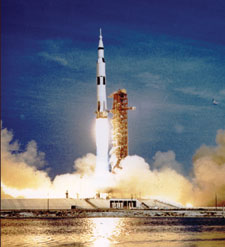
In July 1969, the Apollo 11 astronauts roared into space atop a 363-foot-tall, 6.4-million-pound rocket in the first manned mission to the moon.
NASA/courtesy of nasaimages.org
Otherwise, Mr. Kennedy said, he was "not that interested in space."
These words were uttered in the privacy of the White House, preserved by a secret recording device switched on by the president. But his public rhetoric also was consistent with the idea that being first on the moon was primarily a way of visibly, and peacefully, demonstrating U.S. technological and organizational power.
In his most famous speech on the topic of space, on Sept. 12, 1962, in Houston, Mr. Kennedy declared: "We choose to go to the moon in this decade and do the other things not because they are easy, but because they are hard." (These words, incidentally, did not originate with Mr. Kennedy or his speechwriter Theodore Sorensen; they were part of NASA's input into the speech preparation process.)
The picture that emerges in my book paints John F. Kennedy not as a space visionary but rather as a pragmatic national leader who saw the race to the moon largely as a means to advance broader national interests—not as the first step in a sustained program of space exploration.
Few know it, or remember it, but competing with the Soviet Union in space was in fact Mr. Kennedy's second choice.
He would have much rather found a way to make space an arena for cooperation between the two superpowers, as was apparent at both the beginning and end of his administration.
In his inaugural address in January 1961, Mr. Kennedy had said to the Soviet Union: "Together let us explore the stars." Up to the day of Yuri Gagarin's historic orbital flight—and the president's decision that he had to compete in space—Mr. Kennedy's science and foreign policy advisers had been working on proposals for initiating U.S.-USSR space cooperation.
These proposals had enough momentum to form the basis of an offer by Mr. Kennedy in early June 1961 to cooperate with the Soviet Union in lunar exploration. He made that proposal during a summit meeting with Soviet leader Nikita Khrushchev. It was the only time the pair would meet face to face, and the meeting came just 10 days after Mr. Kennedy had announced his decision to go to the moon.
Mr. Khrushchev rejected that offer, saying that working with the United States would reveal too many of the Soviet military secrets.
While in mid-1961 and 1962 Mr. Kennedy was driven by an imperative to match and then surpass Soviet space capabilities, by 1963 he had come to the conclusion that the United States was making enough progress that the danger of Soviet space domination was rapidly fading.
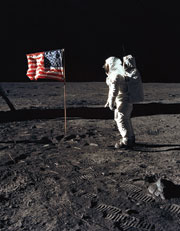
Apollo 11 astronaut Buzz Aldrin stands beside the U.S. flag in the lunar region known as the Sea of Tranquility.
NASA/courtesy of nasaimages.org
In September 1963, Mr. Kennedy went before the General Assembly of the United Nations, bolstered by the U.S. "victory" in the Cuban Missile Crisis, worried by the high costs of continuing the race to the moon, reacting to the growing criticism of Apollo's priority, and hoping in the wake of the Limited Test Ban Treaty to make space the next area of U.S.-Soviet rapprochement.
Addressing the representatives of more than 100 U.N. member states, Mr. Kennedy asked why "should man's first flight to the moon be a matter of national competition?" Instead, he hoped, there would be "room for new cooperation," including "a joint expedition to the moon."
This proposal is little remembered, since it runs so counter to the accepted history of U.S. unilateral success in Project Apollo. But from my research, it seems that Mr. Kennedy was quite serious.
In September 1963, as Mr. Kennedy spoke at the U.N., the Soviet Union still had not decided whether it was going to try to send cosmonauts to the moon. So his proposal came at a sensitive time in the Soviet space program. There is suggestive evidence that Mr. Khrushchev, by 1963, may well have seen cooperation with the United States as a way of having a Soviet lunar effort without bearing all its costs.
Whether that collaboration was actually possible or merely false hope on Mr. Kennedy's part can only be speculated. His assassination two months later removed the possibility, in practice, of a joint U.S.-USSR lunar program; instead, Project Apollo became a memorial to a fallen president.
Three presidents since Mr. Kennedy have proposed resuming human space travel beyond the immediate vicinity of Earth—George H.W. Bush in 1989, George W. Bush in 2004, and Barack Obama in 2010.
The first two proposals literally went nowhere, and the fate of the third remains very uncertain.
Why in 1961 did President Kennedy succeed in launching Project Apollo as no president has been able to do since with similar journeys of exploration?
First of all, Mr. Kennedy was willing to provide the resources required. Following his May 1961 announcement of the lunar landing decision, the NASA budgets he approved provided the funding needed to get started on the very fast-paced Apollo effort, which was by far the U.S. government's largest-ever peacetime program. (Its costs in 2010 dollars would be more than $150 billion; by contrast, the cost of the Panama Canal would be only $8 billion.)

One of the Apollo 11 astronauts leaves an impression in the lunar soil.
NASA/courtesy of nasaimages.org
More recent presidents, beginning with Richard Nixon, have not followed through on their space proposals with adequate budgets. As a result, NASA has struggled in the four decades since Apollo, trying to do too much with too little.
Mr. Kennedy, unlike his successors, also stayed closely involved with the program after his initial space decisions; he visited Cape Canaveral three times and also traveled to other NASA installations. Frequent press conference statements on space provided continuing political support.
On his last visit to the Cape, just six days before he was killed, Mr. Kennedy was visibly excited by the progress being made in U.S. rocket capability. Although some of his advisers were at the time advocating slowing down or even stopping Apollo, it is very unlikely that Kennedy would have approved such a drastic shift in his space plans.
It is my judgment that the circumstances surrounding the lunar decision and its success were unique, a once-in-a-generation—or much longer—convergence of factors that enabled a challenging national commitment and created the momentum to sustain it.
Trying to repeat the Apollo experience is a recipe for frustration and probable failure. Other approaches to space exploration are needed if it is to be sustainable. More broadly, what made Apollo possible cannot serve as a model for other large-scale government efforts; the cliché "If we can send a man to the moon, why can't we . . . ?" is not a useful question to ask.
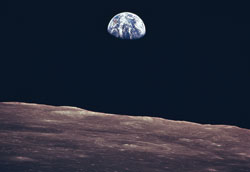
While orbiting the moon, the crew of Apollo 11 captured this stunning glimpse of the distant earth.
NASA/courtesy of nasaimages.org
President Kennedy actually may have struck the right chord for the future back in 1963, when he asked, in addressing the U.N. General Assembly, why man's inaugural visit to the moon needed to be "a matter of national competition" at all. Instead, he proposed "sending some day in this decade to the moon not the representatives of a single nation, but the representatives of all of our countries."
That is a prescient element of Mr. Kennedy's space legacy. Even in 1963 he recognized that it would be preferable to take a global approach to space exploration, with the United States in a leading position. This is even more the case in the 21st century.
As President Kennedy saw it, in a 1962 speech, the pursuit of the moon would "serve to organize and measure the best of our energies and skills." Does this country retain today the desire and the will to once again answer that long ago call, and to take a 21st-century leadership position in the next round of space exploration?
I wish I were a little more optimistic about the answer.
Even so, I retain the hope that I will return to Florida to watch another crew set off for a distant destination. In my view, that destination should once again be the moon; there is a lot more to be learned there.
But whether the destination is the moon, a near-Earth asteroid, or Mars, it is time to go somewhere; time for humans, in the words of Mr. Kennedy, to once more "set sail on this new sea."
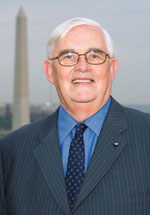
David M. Scavone
About the Author
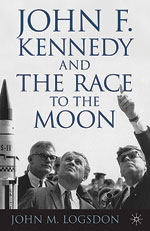 John M. Logsdon is professor emeritus in the Elliott School of International Affairs. During his 38 years of teaching at George Washington, Dr. Logsdon helped educate many young women and men who now are leaders in the U.S. space community and has remained closely involved with the White House, Congress, and NASA in the formation of space policy.
John M. Logsdon is professor emeritus in the Elliott School of International Affairs. During his 38 years of teaching at George Washington, Dr. Logsdon helped educate many young women and men who now are leaders in the U.S. space community and has remained closely involved with the White House, Congress, and NASA in the formation of space policy.
John F. Kennedy and the Race to the Moon was published in December 2010 by Palgrave Macmillan.
